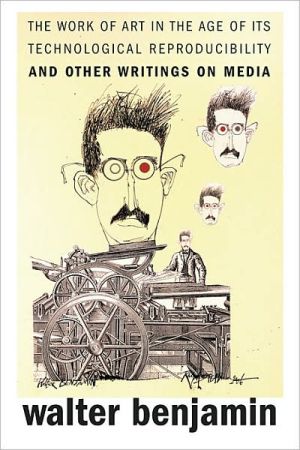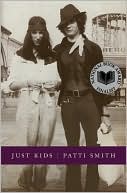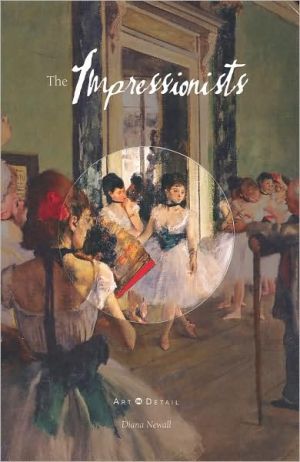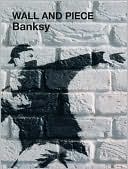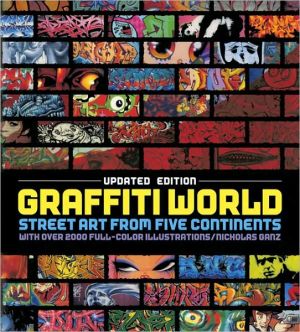The Work of Art in the Age of Its Technological Reproducibility, and Other Writings on Media
Benjamin’s famous “Work of Art” essay sets out his boldest thoughts—on media and on culture in general—in their most realized form, while retaining an edge that gets under the skin of everyone who reads it. In this essay the visual arts of the machine age morph into literature and theory and then back again to images, gestures, and thought.\ This essay, however, is only the beginning of a vast collection of writings that the editors have assembled to demonstrate what was revolutionary about...
Search in google:
Benjamin’s famous “Work of Art” essay sets out his boldest thoughts—on media and on culture in general—in their most realized form, while retaining an edge that gets under the skin of everyone who reads it. In this essay the visual arts of the machine age morph into literature and theory and then back again to images, gestures, and thought. This essay, however, is only the beginning of a vast collection of writings that the editors have assembled to demonstrate what was revolutionary about Benjamin’s explorations on media. Long before Marshall McLuhan, Benjamin saw that the way a bullet rips into its victim is exactly the way a movie or pop song lodges in the soul.This book contains the second, and most daring, of the four versions of the “Work of Art” essay—the one that addresses the utopian developments of the modern media. The collection tracks Benjamin’s observations on the media as they are revealed in essays on the production and reception of art; on film, radio, and photography; and on the modern transformations of literature and painting. The volume contains some of Benjamin’s best-known work alongside fascinating, little-known essays—some appearing for the first time in English. In the context of his passionate engagement with questions of aesthetics, the scope of Benjamin’s media theory can be fully appreciated.George Fetherling - Seven OaksA juicy selection of [Benjamin's] many short pieces on pop culture.
I The Production, Reproduction, and Reception of the Work of Art1 The Work of Art in the Age of Its Technological Reproducibility: Second Version 192 Theory of Distraction 563 To the Planetarium 584 Garlanded Entrance 605 The Rigorous Study of Art 676 Imperial Panorama 757 The Telephone 778 The Author as Producer 799 Paris, the Capital of the Nineteenth Century 9610 Eduard Fuchs, Collector and Historian 11611 Review of Sternberger's Panorama 158II Script, Image, Script-Image12 Attested Auditor of Books 17113 These Surfaces for Rent 17314 The Antinomies of Allegorical Exegesis 17515 The Ruin 18016 Dismemberment of Language 18717 Graphology Old and New 192III Painting and Graphics 21918 Painting and the Graphic Arts 22119 On Painting, or Sign and Mark 22120 A Glimpse into the World of Children's Books 22621 Dream Kitsch 23622 Moonlit Nights on the Rue La Boerie 24023 Chambermaids' Romances of the Past Century 24324 Antoine Wiertz: Thoughts and Visions of a Severed Head 24925 Some Remarks on Folk Art 25426 Chinese Paintings at the Bibliotheque Nationale 257IV Photography27 News about Flowers 27128 Little History of Photography 27429 Letter from Paris (2): Painting and Photography 29930 Review of Freund's Photographie en France au dix-neuvieme siecle 312V Film31 On the Present Situation of Russian Film 32332 Reply to Oscar A. H. Schmitz 32833 Chaplin 33334 Chaplin in Retrospect 33535 Mickey Mouse 33836 The Formula in Which the Dialectical Structure of Film Finds Expression 340VI The Publishing Industry and Radio37 Journalism 35338 A Critique of thePublishing Industry 35539 The Newspaper 35940 Karl Kraus 36141 Reflections on Radio 39142 Theater and Radio 39343 Conversation with Ernst Schoen 39744 Two Types of Popularity: Fundamental Reflections on a Radio Play 40345 On the Minute 407Index 411
\ Seven OaksA juicy selection of [Benjamin's] many short pieces on pop culture.\ — George Fetherling\ \ \ \ \ \ Times Literary SupplementUntil recently, Walter Benjamin‘s seminal essay, The Work of Art in the Age of Its Technological Reproducibility, was available to English-speaking readers only in the version that appeared in the 1968 collection Illuminations. Harvard’s new volume of the German cultural critic’s writings on media offers as its title-piece an earlier, edgier incarnation—the second of three composed between 1935 and 1939—in a superior translation...Throughout The Work of Art in the Age of Its Technological Reproducibility, Benjamin‘s startling, often oblique language reveals his subjects from unexpected angles...This volume amply demonstrates the keenness and ingenuity of Benjamin‘s intuitions at the dawn of modern media culture.\ — Ross Benjamin\ \ \ \ UmbrellaThe Work of Art in the Age of its Technological Reproducibility and other Writings on Media reflects Benjamin's most salient thoughts on media and on culture in general in their most realized form, still maintaining an edge under the skin of everyone who reads it. The visual arts morph into literature and theory and then back to images, gestures and thought, Here the editors have situated this essay as the cornerstone of a vast collection of writings that demonstrates what was revolutionary about Benjamin's explorations on media. He was so prescient, and mind you, Virginia, he was alive only until 1940. We are now talking about 2008 and his work is not just timely, but powerful, important, clairvoyant, and necessary. This is the second and most daring version of the 'Work of Art' essay which tracks Benjamin's observations on the production and reception of art; on film, radio, and photography; on the telephone, on children's books, on Charlie Chaplin and so much more. He was not a critic for the 20th century, he was a theoretician for all time. This volume will probably become a text for some classes, but it is an introduction, a force that must be dealt with by anyone interested in culture, in the media, in the arts, to debates on the digital age. He could explore implications of these themes and be so prescient about what we are experiencing today. Oh, if he were alive today, he would tell us about the future, I am sure. This is a must for anyone who wants to be introduced to Benjamin, or one who wants more and more of what he has to say—and this one is thankfully in English.\ \ \ \ \ \ The NationThe editors and publisher of this volume deserve credit for organizing its contents thematically rather than chronologically. Such a format encourages readers to approach Benjamin's work discursively, thereby fostering a superior sense of the recurrent ideas, themes, motifs and concepts that Benjamin employed time and again.\ — Noah Isenberg\ \ \ \ \ \ The NationThe editors and publisher of this volume deserve credit for organizing its contents thematically rather than chronologically. Such a format encourages readers to approach Benjamin's work discursively, thereby fostering a superior sense of the recurrent ideas, themes, motifs and concepts that Benjamin employed time and again.\ — Noah Isenberg\ \ \ \ \ Times Literary SupplementUntil recently, Walter Benjamin‘s seminal essay, The Work of Art in the Age of Its Technological Reproducibility, was available to English-speaking readers only in the version that appeared in the 1968 collection Illuminations. Harvard’s new volume of the German cultural critic’s writings on media offers as its title-piece an earlier, edgier incarnation--the second of three composed between 1935 and 1939--in a superior translation...Throughout The Work of Art in the Age of Its Technological Reproducibility, Benjamin‘s startling, often oblique language reveals his subjects from unexpected angles...This volume amply demonstrates the keenness and ingenuity of Benjamin‘s intuitions at the dawn of modern media culture.\ — Ross Benjamin\ \ \ \ \ UmbrellaThe Work of Art in the Age of its Technological Reproducibility and other Writings on Media reflects Benjamin's most salient thoughts on media and on culture in general in their most realized form, still maintaining an edge under the skin of everyone who reads it. The visual arts morph into literature and theory and then back to images, gestures and thought, Here the editors have situated this essay as the cornerstone of a vast collection of writings that demonstrates what was revolutionary about Benjamin's explorations on media. He was so prescient, and mind you, Virginia, he was alive only until 1940. We are now talking about 2008 and his work is not just timely, but powerful, important, clairvoyant, and necessary. This is the second and most daring version of the 'Work of Art' essay which tracks Benjamin's observations on the production and reception of art; on film, radio, and photography; on the telephone, on children's books, on Charlie Chaplin and so much more. He was not a critic for the 20th century, he was a theoretician for all time. This volume will probably become a text for some classes, but it is an introduction, a force that must be dealt with by anyone interested in culture, in the media, in the arts, to debates on the digital age. He could explore implications of these themes and be so prescient about what we are experiencing today. Oh, if he were alive today, he would tell us about the future, I am sure. This is a must for anyone who wants to be introduced to Benjamin, or one who wants more and more of what he has to say--and this one is thankfully in English.\ \ \ \ \ Seven OaksA juicy selection of [Benjamin's] many short pieces on pop culture.\ — George Fetherling\ \ \ \ \ Library JournalThis essay collection by German literary critic and philosopher Benjamin (1892-1940) covers his theories on the relationships between and among culture, history, and art media. The editors have chosen his essays that focus on technologies and art media of the early 20th century, e.g., radio, film, and photography. The first section covers Benjamin's theories on the political possibilities of art and the effects of art on human thought. The second offers brief introductions to Benjamin's application of his theories to specific art media and technologies. Benjamin explains that art media, like film and photography, enables the creation of reproducible works, a fact that has both politicized art and revolutionized our perception of it. Art works, he writes, have become a "collective creation" rather than something created by an individual. While Benjamin's writing style can make his line of reasoning difficult to follow, the editors have done a wonderful job of introducing each section with a historical overview of the essays and a thorough explanation of his theories. Highly recommended for academic and large public libraries.\ —Scott Duimstra\ \ \
